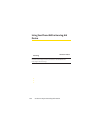
168 Section 4A: ImportantSafety Information
ⅷ
Never dispose of the battery by incineration.
ⅷ
Keep the metal contacts on top of the battery clean.
ⅷ
Don’t attempt to disassemble or short-circuit the battery.
ⅷ
The battery may need recharging if it has not been used for a long period
of time.
ⅷ
It’s best to replace the battery when it no longer provides acceptable
performance. It can be recharged hundreds of times before it needs
replacing.
ⅷ
Don’t store the battery in high temperature areas for long periods of
time. It’s best to follow these storage rules:
Less than one month:
-4° F to 140° F (-20° C to 60° C)
More than one month:
-4° F to 113° F (-20° C to 45° C)
Disposal of Lithium Polymer Batteries
Do not handle a damaged or leaking Lithium Polymer battery as you can be
burned.
For safe disposal options of your Lithium Polymer batteries, contactyour
nearest Sprint authorized service center.
Special Note: Be sure to dispose of your battery properly. In some areas,
the disposal of batteries in household or business trash may be prohibited.
Radiofrequency (RF) Energy
Understanding How Your Phone Operates
Your phone is basically a radio transmitter and receiver. When it’s turned
on, it receives and transmits radiofrequency (RF) signals. When you use
your phone, the system handling your call controls the power level. This
power can range from 0.006 watts to 0.2 watts in digital mode.
Knowing Radiofrequency Safety
The design of your phone complies with updated NCRP standards described
below.
In 1991-92, the Institute of Electrical and Electronics Engineers (IEEE) and
the American National Standards Institute (ANSI) joined in updating ANSI’s
1982 standard for safety levels with respectto human exposure to RF
signals. More than 120 scientists, engineers and physicians from


















